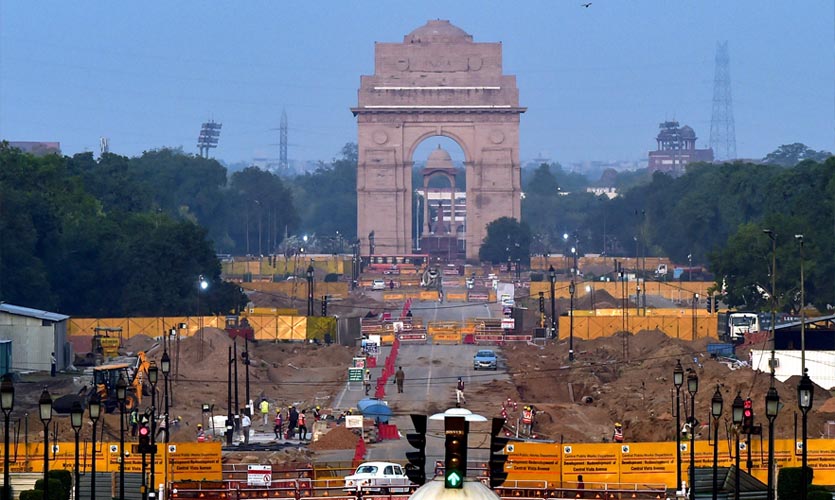Recently, when the central government announced the Central Vista Project, it didn’t just touch the nerve of archaeologists, historians, environmentalists and artists worldwide, but also every art, culture and history-loving Indian.
Delhi – the capital of India – a city that holds within itself 8 different historical cities like Lal Kot, Siri, Tughlaqabad, Jahanpanah, Firozabad, Dinpanah, Shahjahanabad and Lutyens’ Delhi. This fact alone is enough to indicate its historical legacy, grandeur and rich heritage.
If you come to Delhi, you will find it similar to other modern Indian metropolises with its utilitarian buildings, malls, hospitals and bigger-but-congested roads. Then, suddenly, you will enter the Lutyens’ enclave and know why it is a cultural symbol and a national treasure.
Modelled on European Cities of the Renaissance, this tiny enclave is an escape from the rest of the city’s squalor and chaos. Marked with its signature – sprawling white-colored bungalows, roads adorned with specific species of trees, roundabouts and abundant green space; it is the low-density, eco-friendly and highly exclusive space in the heart of the national capital.
Designed by British artist-architect Edward Lutyens, the magnificent architecture of the enclave manages to encapsulate the secular spirit and the pluralist past of India. While designing, a conscious approach was adopted to incorporate Mughal and Rajput elements into the construction, and blend the new city with the rest of the historical sites. It is this beautiful amalgamation of Eastern and Western sensibilities, proudly on display in the Lutyens’ region, that is admired by all visitors.
Loss Of History
With the announcement of the redevelopment of Central Vista project, it is the residents of Delhi who feel the loss even more deeply. Resident Srishti Jesingh, who has lived in Delhi all her life says, “The soul of Delhi is its aesthetically pleasing vibe, greenery and the monuments. I believe, something like the Central Vista Project is only going to wear out Delhi’s soul.”
Some of them have come to associate the current government with an authoritarian regime, that has no regard for the voices or opinions of the citizens, Nikita Khosla, a teacher at the Delhi Public School, compared India with the fictional state of Oceania from George Orwell’s book 1984, she says, ”I have come to associate India with Oceania and myself as one of the proles living in the state of blissful ignorance. We shouldn’t voice out our feelings, views and opinions lest the ‘thought police’ will come and eliminate us.”
Read about this company that’s turning pollution into black ink
While some are angry, others are sad at the loss of a beautiful vista of Rajpath. Lubhavani Anand, a research associate, who was born in Delhi and only recently moved to Mumbai, cannot believe she won’t be able to drive on the Rajpath road anymore. Recollecting her old days, she said, “One of my fondest memories of Delhi is me driving on the Rajpath road. There are trees on both sides of the road and that is one of my favorite visuals in the city. Every time I come back home, I make sure to take that drive. It breaks my heart to think that won’t be possible anymore.”
The iconic India Gate and its surrounding gardens, that come alive at night with huge crowds of visitors and vendors, are one of the areas that were open to public access, but won’t be anymore. This is another punch in the gut for those who have fond memories of the place, Nikita nostalgically revisited her childhood memory and says, “I remember enjoying my ice-cream on a Sunday evening at the India Gate parks and looking at the sea of people, smiling in bliss with their loved ones. This was my heritage while growing up.”
Apart from being a popular leisure site, India Gate is the emblem of the fighting spirit of Delhi and its people. The site of the Nirbhaya protests that sparked a new enthusiasm in the Indian youth is another loss too heavy to bear. Srishti recollected her most precious memory and said, “The one memory I hold dear to me was the screening of Rang De Basanti organised under the stars at India Gate.” Rang De Basanti, set in Delhi, is the movie that perfectly captured the revolutionary sentiments of the city and its youth population, with Lutyens’ enclave as the appropriate backdrop.
The Central Vista Campus
The buildings being demolished, to create a ‘campus’ where all ministries will be concentrated, include Indira Gandhi National Centre for the Arts, National Museum and Jawaharlal Nehru Bhawan. The cost of this efficiency-boosting move is the risk of losing hundreds of years old national and international artifacts.
Nancy Gupta, another concerned resident doubtful of this move says, “I believe infrastructure acts as a facilitator and not an efficiency booster. I believe there’s still a lot of paper/file channels that move around, which delay the work and put efficiency in question. Building a digital platform within the workspace poses greater scope of efficiency, according to me.”
A doubtful cause of efficiency, loss of art and architecture, a threat to the environment and stealing Delhiites of their public spaces – is what the residents think this project stands for. “I always tell everyone that history is geography in Delhi,” said KS Rajendran, a professor at the National School of Drama once in an interview, and today we stand at losing both the history and geography of Delhi. It is the next generation which is at the most loss here, for not being able to experience Delhi in all its true glory.










